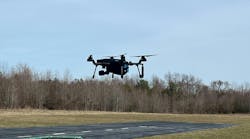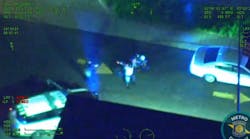More and more, law enforcement—particularly those in investigations—have to contend with the advancement of technology. Cellphones have become a near constant in Western society and the cloud universe of applications and storage continues to expand. Through these applications and the networks that support them, an almost perfect blueprint of our daily activities is collected. This blueprint has proven to be a useful tool for law enforcement. It is also the subject of a recent Supreme Court decision that is the current talk of the trade.
Carpenter v. United States (2018)
In brief, Timothy Carpenter was a suspect in a number of armed robberies. Police used an order issued under the Stored Communications Act to get his cell-site location information (CSLI). This time-stamp occurs anytime the phone is actively used for texting, calls and with applications. It also occurs many times when the phone is inactive, with applications and when roaming. As the demand increases, as well as increased focus on location accuracy, CSLI becomes more and more precise. The majority decision notes, “The accuracy of CSLI is rapidly approaching GPS-level precision.” Although this claim has been described as broad and depends on a number of factors, no one argues that CSLI will not continue to get more accurate.
Based on his CSLI, Carpenter was determined to be physically in the vicinity of a number of the armed robbery sites, convicted and sentenced to over 100 years. He appealed to the SCOTUS stating the police’s acquisition of his CSLI was a search in violation of the Fourth Amendment. Chief Justice Roberts giving the majority opinion agreed, overturning the lower courts’ decisions.
Influence on law enforcement
Although some media attention leads law enforcement to believe Carpenter to be crippling, that’s far from the truth. Essentially, the ruling just states that because of the private nature of CSLI, an order based on “reasonable grounds” will no longer be sufficient to gather more than six days worth of information. Instead, a search warrant based on probable cause is required.
Ken Wallentine, supervisory special agent for the Utah Attorney General and a 36-year law enforcement veteran explains the effect on street cops today is minimal. But for investigators, particularly those who are involved in violent crime or who rely on technological skills, the decision is significant. “It shifts the burden of requiring officers to get a warrant versus an order,” he explains. “It’s not terribly more difficult but it adds another layer of judicial review in an investigation.”
Lee Reiber, chief operating officer, Oxygen Forensics Inc and former police officer, agrees. “When the ruling came out, I contacted some law enforcement officers,” he states. “I talked to [many] departments and all have been getting search warrants.”
Wallentine goes on to explain that it’s uncommon for a search warrant to get turned down, but the ruling will have judges taking a closer look. “I don’t think that on the law enforcement side of it, it’s going to be very difficult for our jobs,” says Reiber. “It’s an affirmation from the Court holding up the privacy for data. Law enforcement is pretty comfortable with the ruling.” The majority decision supports this, stating, “Before compelling a wireless carrier to turn over a subscriber’s CSLI, the Government’s obligation is a familiar one—get a warrant.”
The Fourth Amendment foundation
Although this shift seems less than revolutionary, this ruling is anything but ordinary. “Carpenter is just one of a number of decisions that is waking judges up,” states Wallentine. “They say we have to try and keep up with privacy rights in a technological age. Under Chief Justice Roberts, they are willing to engage the issue of privacy. They are moving towards looking at technology more closely.” Carpenter builds on the Court’s opinion that cellphones have become like human anatomy essential to life in modern society. Wallentine doesn’t completely agree. “I think it’s ludicrous. People still have a choice. Roberts is way overstating the ubiquitous nature and understating the choice that people still have. I meet that claim with derision but go back to Riley and Wurie where the Court began to explore the notion that mobile phones are so much more than telephones. It truly does contain a snapshot of my entire life and incredibly private data.” The revolutionary aspect of recent cases, including Carpenter, is the Court’s analytical framework of the Fourth Amendment.
At the heart of Carpenter is the concept of privacy and how it applies to emerging technology. In the majority decision, Roberts explains the pervasive nature of cellphone use. He also notes historically it has been expensive and time consuming to track someone for an extended period of time. Now through CSLI, “a near perfect accounting of a person’s movements is available.” These movements give the government access to associations, such as family, political, professional, spiritual and even sexual, a concern warned against in United States v. Jones (2012). The Court notes in Carpenter, “like GPS monitoring, cellphone tracking is remarkably easy, cheap and efficient compared to traditional investigative tools. With just the click of a button, the Government can access each carrier’s deep repository of historical location information at practically no expense.” Jones addressed monitoring a vehicle which people can get out of and leave behind. Unlike a vehicle, the Court states people “compulsively carry cellphones with them all the time,” even noting 12 percent of people admit to even bringing their smartphones into the shower. The Court explains, “When the Government tracks the location of a cellphone it achieves near perfect surveillance, as if it had attached an ankle monitor to the phone’s user.” Professor Laura Donohue, cited in Thomas’ dissent expands on this describing the shadowing of our cell imprint as our “digital ‘person.’”
Another privacy concern noted in Carpenter is the ability for officers to conduct surveillance before the fact. The Court notes, “People need not even know in advance whether they want to follow a particular individual, or when. Whoever the suspect turns out to be, he has effectively been tailed every moment of every day for five years…Only the few without cellphones could escape the tireless and absolute surveillance.” Laura Moy, executive director, Center on Privacy & Technology furthers, “The Supreme Court was really captivated by the fact that because we carry our cellphones with us everywhere we go, and because cell-site location records are maintained for years, cell-site location records offer law enforcement something like a time machine that they can use to go back in time and plot out where an individual may have been in great detail many months ago. This is why this type of evidence is so useful for law enforcement—and it’s also why consumers might expect the information to be kept private.”
Kennedy, Thomas and Alito’s dissents disagree with the reasonable expectation of privacy, a people-based framework outlined by the majority instead relying on a property-based interpretation. Gorsuch calls this a “more traditional Fourth Amendment approach.” He also states it should be the legislative not the judicial branch answering the ‘empirical’ or ‘normative’ question reference the subjective nature of ‘reasonable’, explaining, “The Amendment’s protections do not depend on the breach of some abstract ‘expectation of privacy’ whose contours are left to the judicial imagination. Much more concretely, it protects your ‘person,’ and your ‘houses, papers, and effects.’ Nor does your right to bring a Fourth Amendment claim depend on whether a judge happens to agree that your subjective expectation to privacy is a ‘reasonable’ one. Under its plain terms, the Amendment grants you the right to invoke its guarantees whenever one of your protected things (your person, your house, your papers, or your effects) is unreasonably searched or seized. Period.”
In Kennedy’s dissent, he argues, “The Court’s newly conceived constitutional standard will cause confusion; will undermine traditional and important law enforcement practices; and will allow the cellphone to become a protected medium that dangerous persons will use to commit serious crimes.” Alito shares this stating, “I share the Court’s concern about the effect of new technology on personal privacy, but I fear that today’s decision will do far more harm than good. The Court’s reasoning fractures two fundamental pillars of Fourth Amendment law, and in doing so, it guarantees a blizzard of litigation while threatening many legitimate and valuable investigative practices upon which law enforcement has rightfully come to rely.”
The whole is bigger than the parts
Although Carpenter addresses only one kind of technology, the question for law enforcement is what the future holds. “While the majority opinion notes that its decision is a ‘narrow one,’ there is an expansive legal shift in the acceptance of a protected privacy interest in aggregated data, each piece of which is not privacy protected,” Donald Zoufal, attorney and law enforcement adviser explains. “This adoption of a theory that the whole is more than the sum of the parts has been long debated in a series of court cases. It is now established as a Fourth Amendment imperative.” Zoufal goes on to describe how we are entering the dawn of an era. “The ability of the government to access growing amounts of available digital data from video sensors and other sensors in the Internet of Things (IoT) is clear,” he states. “While the opinion notes that it specifically does not ‘question conventional surveillance techniques and tools, such as security cameras,’ what if the data gathered and analyzed using those tools becomes increasingly pervasive and simple? Despite its disclaimer that surveillance techniques are undisturbed by the opinion, the nature of modern technology-enhanced surveillance is opened to a new round of scrutiny by the Court’s opinion.”
How does law enforcement proceed?
Carpenter does allow for real-time tracking of cellphones during exigent circumstances, but for “mine-run criminal investigation” it’s a bit less clear. In regards to this ambiguity, Zoufal gives some clear factors for law enforcement to consider, including:
The importance of the activity generating the data—the Court noted the importance of cellphones in modern society
The duration of data collection—the Court noted that the data was generated by the ordinary and continuous function of the cellphone without independent action by the owner beyond powering it up (the absence of independent action seemed to undercut the concepts of notice and consent)
The pervasiveness of data collection—the Court observed both the pervasiveness of cellphones in society and the pervasiveness of the data collected by the constant operation of the devices as they search for cellular sites
The sensitivity of other activity evidenced by data collection—the Court noted that the records did not just show voluntary usage activity but showed the location of the cellphone even when it was merely carried, not used
While SCOTUS hashes out the analytical framework of the Fourth Amendment, emerging technology and investigations continue to march on and CSLI is not the only way to acquire valuable information. Oxygen Forensics Inc offers law enforcement customers software to access digital forensics. “Our software allows us to access any geo, metadata or third party application, as well as, any Wi-Fi or cellular hits,” says Reiber. “We put that information in our timeline section. We put those points on a map.” He explains how the software allows three mapping levels. First, it shows common places an individual frequents, such as home, a restaurant or their girlfriend’s house. The second level takes the raw data and formulates routes based on specific criteria for example if an officer wants to find a potential route where a homicide weapon was discarded. The third level, which Reiber states is the most important, allows officers to make connections between suspects. “We can take all that information and based on the common information and criteria, say Show me all the points within five meters within five seconds and it will overlay these individuals,” he states. “Back two weeks ago, you were both standing right here (in the same location) texting or whatever. Look, you’re actually talking to each other even though you said you just met.” In reference to digital forensics, Reiber doesn’t see Carpenter making an impact although there might be problems down the road, such as not allowing law enforcement access to cloud data or increased restrictions on biometrics, such as facial recognition.
Carpenter is a landmark case in a number of ways. It shows the Court’s willingness to tackle the complicated issues of modern technology while staying firmly seated in the Constitution. “I think we will see the Court continue to march towards protecting privacy but being very aware of how privacy protections will impact law enforcement and national security,” Wallentine states.
About the Author
Michelle Perin has been a freelance writer since 2000. In December 2010, she earned her Master’s degree in Criminology and Criminal Justice from Indiana State University.



